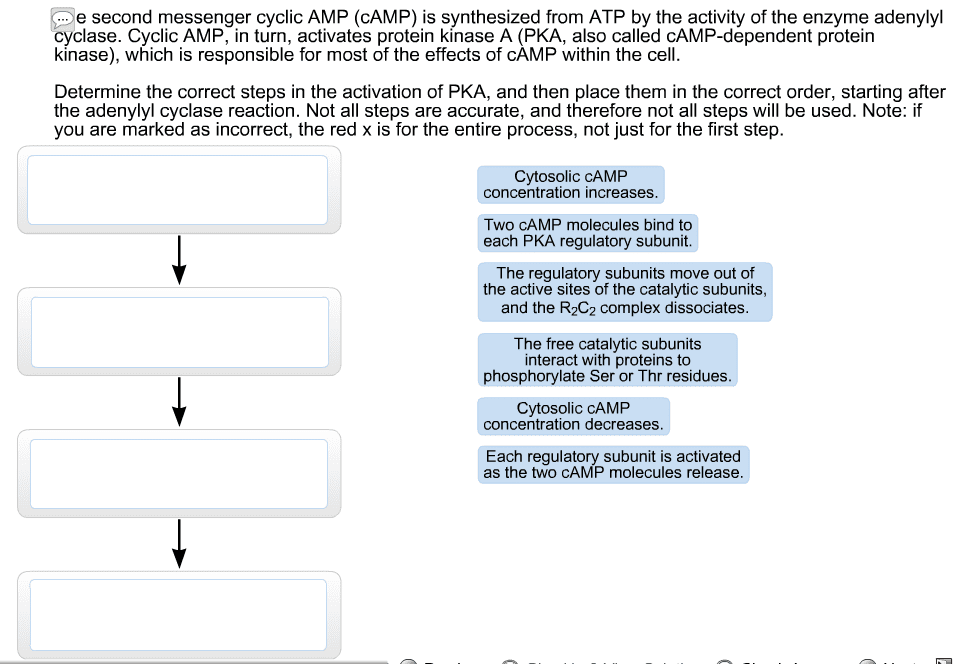BCMB 311 Chapter Notes - Chapter 16: Thioester, Threonine, Molecular Switch
Document Summary
Get access


Related Documents
Related Questions
QUESTION 1
Which of the following is an example of an extracellular signal molecule?
| a. | IP3 | |
| b. | cAMP | |
| c. | Insulin | |
| d. | Diacylglycerol |
2 points
QUESTION 2
Nuclear hormone receptors _____
| a. | Bind to water soluble ligands | |
| b. | Activate second messengers | |
| c. | Regulate transcription in response to ligand binding | |
| d. | Are normally located on the plasma membrane |
2 points
QUESTION 3
Which of the following does not occur when a receptor tyrosine kinase is bound by ligand?
| a. | Phosphorylation of the RTK | |
| b. | Cytoplasmic proteins bind the phosphorylated RTK | |
| c. | Dimerization of the RTK | |
| d. | The RTK binds to DNA to regulate transcription |
2 points
QUESTION 4
Which of these is a logical signal-transduction pathway?
| a. | An intracellular receptor activates phospholipase C, which cleaves a membrane protein to form IP3, which then activates the opening of an ER channel protein, which releases cyclic AMP into the cytoplasm, where it binds to an intracellular enzyme that carries out a response. | |
| b. | A G-protein-linked receptor activates G protein, which activates phospholipase C, which cleaves a membrane lipid to form IP3, which binds to a calcium channel on the ER, which opens to release calcium ions into the cytoplasm, which bind to an intracellular enzyme that carries out a response. | |
| c. | An ion-channel receptor opens, allowing a steroid hormone to enter the cell; the steroid hormone then activates protein kinases that convert GTP to GDP, which binds to an intracellular enzyme that carries out a response. | |
| d. | A tyrosine-kinase receptor activates adenylyl cyclase, which activates phospholipase C, which converts ATP into cyclic AMP, which binds to an intracellular enzyme that carries out a response. |
2 points
QUESTION 5
Which of the following is an example of signal amplification?
| a. | activation of an enzyme molecule | |
| b. | activation of a specific gene by a growth factor | |
| c. | Breakdown of many cAMP molecules | |
| d. | activation of 100 molecules by a single signal binding event |
2 points
QUESTION 6
Consider a signal transduction pathway that utilizes cAMP as a second messenger to activate PKA (Protein Kinase A). Which of the following situations will result in the cellular response?
| The G protein releases GDP and binds to GTP | ||
| The target protein (adenylyl cyclase) is inactive | ||
| The regulatory subunits of PKA (Protein Kinase A) are bound to the catalytic subunits | ||
| The appropriate G protein is bound to GDP |
2 points
QUESTION 7
Which of the following is found in only some signal transduction pathways? [In other words, which is not found in all signal transduction pathways?]
| Receptor protein | ||
| Extracellular signal molecule | ||
| Intracellular signaling molecule | ||
| Cellular response | ||
| Effector protein |
2 points
QUESTION 8
The enzyme that specifically catalyzes the conversion of ATP to cAMP is:
| Adenylyl phosphatase | ||
| Adenylyl kinase | ||
| Adenylyl dehydrogenase | ||
| Adenylyl cyclase |
2 points
QUESTION 9
If an animal cell suddenly lost the ability to produce GTP, what might happen to its signaling system?
| It would use ATP instead of GTP to activate and inactivate the G protein on the cytoplasmic side of the plasma membrane. | ||
| It would not be able to activate and inactivate the G protein on the cytoplasmic side of the plasma membrane. | ||
| It would employ a transduction pathway directly from an external messenger. | ||
| It would be able to carry out reception and transduction but would not be able to respond to a signal. |
2 points
QUESTION 10
A hormone signal is sent from the brain to other parts of the body via the bloodstream. Why do only certain cells respond to this signal?
| Hormones do not last long enough in the bloodstream to stimulate a cellular response | ||
| Only cells that have a specific transcription factor gene will be able to respond to the signal | ||
| Only cells in the immediate vicinity of the cell sending the signal will respond | ||
| Only cells that have a receptor for the specific signal will be able to respond to it |

